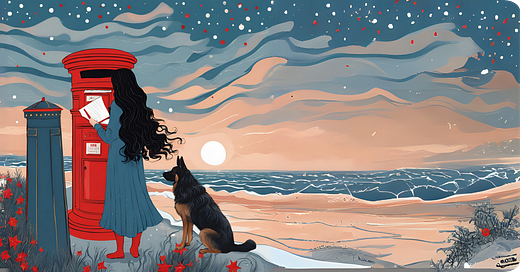Christmas Mail
The first Christmas card, a card from me, a Christmas poem, and a how-to write your own.
Dear you—
With a handful of blue envelopes, I ambled toward the post box in town — that iconic pillar box1 you see on postcards. I smiled at a woman who reached the box before me. She dropped her own handful of envelopes into the narrow slit at the top of the vertical pillar. I stepped in behind her and slid my envelopes into the box. Without exchanging a word, we knew that we were both sending our Christmas cards. I wondered what images were on her cards. What did she choose? A snowy winter scene? A sparkling Christmas Tree? A reindeer? Santa? Or some religious themed scene - the baby, the manger, the three wise men? A postbox? A robin? Something funny?
As I walked away from the post box, I saw a red Royal Mail van drive up towards the depot. I imagined all the cards contained inside and all the scenes on them. I remembered one of my favourite Christmas poems, and I started writing this letter simply to share this with you.
Christmas Mail
By Ted Kooser2
Cards in each mailbox, angel, manger, star and lamb, as the rural carrier, driving the snowy roads, hears from her bundles the plaintive bleating of sheep, the shuffle of sandals, the clopping of camels. At stop after stop, she opens the little tin door and places deep in the shadows the shepherds and wise men, the donkeys lank and weary, the cow who chews and muses. And from her Styrofoam cup, white as a star and perched on the dashboard, leading her ever into the distance, there is a hint of hazelnut, and then a touch of myrrh.
*** Scroll down to the end of this letter for a How-To create your own Christmas poem ***
The first Christmas card
Now, what was on the very first Christmas card?

According to the Victoria and Albert Museum, London3, Henry Cole (1808 – 1882), a prominent civil-servant, educator, inventor and the first director of the Museum, asked his painter friend — in December 1843 — John Callcott Horsley to illustrate a card. The tradition would have been to send letters, I imagine, but a card would be a time-saving solution for the busy Cole household. The Horsley design shows three generations of the Cole family drinking wine, while also in other scenes feeding and clothing the less fortunate.
What scenes do you choose for your Christmas cards?
As for mine, this year I co-created a card with AI which I include below for you.
A card from me to you
How to create your own Christmas Mail poem.
If you take another look at Christmas Mail by Ted Kooser, you can identify four parts to the poem.
A list of images on Christmas greeting cards. For example, angel, manger, star and lamb.
A list of sounds associated with the images on the cards. For example, bleating, shuffling, clopping.
A list of smells associated with the images on the cards. For example, hazelnut and myrrh.
And the story of the rural letter carrier, the postal service employee.
To create your own poem, simply create a few lists and then shape them into a story.
Select a few Christmas cards.
List everything you see on them.
List the colours you see.
List any symbols or other meaningful marks.
List any sounds you associate with the images.
List any smells you associate with the images.
Now, think of a story with some action. In the poem, you have the rural carrier driving, opening up post boxes, and drinking a fragrant warm beverage in a cup.
Put everything together.
And there you have a Christmas poem.
Oh, go on, share in the comments too.
It was the famous novelist, Anthony Trollope, who proposed the introduction of such boxes in Britain in the 1850s. He was working as a Surveyor’s Clerk for the Post Office. According to the Postal Museum, he might have seen letter boxes in France and Belgium. After a trial on the island of Jersey and then Guernsey, they appeared on the British mainland from 1853.
Read about Ted Kooser at The Poetry Foundation and on his website.











A very merry Christmas to you and Henrietta! Aussie Christmas has already started so I'm getting in first :)